3D Underground Property Rights of Transportation Infrastructures: Case Study of Piraeus Metro Station, Greece
Abstract
:1. Introduction
2. Literature Review
3. Metro Network Underground Property Rights in Greece: Current Status
3.1. Underground Property Rights and Public Infrastructures in Greece
3.2. Cadastral Records and Underground Transportation Networks Property Rights
3.2.1. Hellenic Cadastre Spatial Records
- The 2D Spatial/geometrical description of each distinct land parcel/plot, Hellenic Cadastre Spatial DB (HCSDB);
- Legal description of property rights (in legal binding documents, e.g., deeds, official administrative acts published in the Official Government Gazette of the Hellenic Republic, etc.), legal restrictions on property rights, for each distinct land parcel/plot, Hellenic Cadastre Descriptive DB (HCDDDB).
3.2.2. Underground Transportation Networks Property Rights and Hellenic Cadastre
3.3. The Athens Metro
Athens Metro 3D Underground Property Rights Definition
- Full ownership underneath areas expropriated according to PL Art. 1001 for metro development, owned by Attiko Metro SA;
- Enhanced property rights of Attiko Metro SA for the use, exploitation, management and maintenance of the three-dimensional space formed by entrances construction;
- Enhanced property rights of Attiko Metro SA for the use, exploitation, management and maintenance of the three-dimensional space formed by the main station infrastructures, developed in multiple levels;
- Enhanced property rights of Attiko Metro SA for the use, exploitation, management and maintenance of the tunnels three-dimensional space;
- The three-dimensional space underneath the station, owned by the surface plot owner;
- The three-dimensional space from surface level to tunnels, owned by the surface plot owner as defined in PL Art. 1001;
4. Defining 3D Underground Property Rights of Attiko Metro Piraeus Station
4.1. Piraeus Station 2D Model Construction
4.2. Pireaus Station 3D Model Construction
4.3. Piraeus Station 3D Underground Property Rights Definition
- Metro Line 1 Station cadastral parcel, private property of Urban Rail SA;
- Part of the cadastral parcel Special Area—road network, Akti Kallimatsioti, exempt from transactions, property of Piraeus Municipality;
- Public Square Odyssou cadastral parcel, property of Piraeus Municipality;
- Part of the Piraeus Port Exclusive Zone cadastral parcel, property of the Ministry of Finance.
- The UUS layers, formed by the intersection of the Piraeus Station 3D model intersection to the 3D model of the official parcels, are entrances, which are vertically developed from level 0 to level−1. They have the smaller 2D boundary, overlapping part of Line 1 Station, Odyssou Sqr and Akti Kallimatsioti and Piraeus Port Exclusive Zone cadastral parcels, property of Urban Rail SA, Piraeus Municipality and Ministry of Finance, respectively.
- Entrances’ infrastructures, including staircases and escalators that divide the UUS into two 3D fragments: the under the ground level entrance’s 3D space and the below the entrance 3D space.
- Mechanical area levels where all the necessary mechanical equipment for station’s operation is placed. The central ventilation system is vertically developed from level 0 to level 1 and within level 1, while the main mechanical machinery is in operation in level 1. The mechanical area 2D boundary overlaps a small part of the Line 1 Station and Piraeus Port Exclusive Zone cadastral parcels, between levels 0 and 1, while the main mechanical area in level 1 overlaps part of the Akti Kallimatsioti cadastral parcel.
- The concourse and platform levels are developed underneath the main mechanical area level, in levels 2 and 3, respectively. Their 2D boundaries are completely identical to the 2D mechanical area boundary, overlapping only part of the Akti Kallimatsioti cadastral parcel.
- Tunnel and platform foundations are developed in level 4. Foundations have a smaller 2D boundary, compared with the mechanical, concourse and platforms levels that overlaps only the Akti Kallimatsioti cadastral parcel.
- Tunnel foundations outside the station overlap only the Akti Kallimatsioti cadastral parcel.
5. Discussion and Conclusions
Author Contributions
Funding
Institutional Review Board Statement
Informed Consent Statement
Data Availability Statement
Conflicts of Interest
References
- United Nations, Department of Economic and Social Affairs, Population Division. World Urbanization Prospects, The 2018 Revision; United Nations: New York, NY, USA, 2019; Available online: https://population.un.org/wup/Publications/Files/WUP2018-Report.pdf (accessed on 1 September 2021).
- Kim, S.; Heo, J. Development of 3D underground cadastral data model in Korea: Based on land administration domain model. Land Use Policy 2017, 60, 123–138. [Google Scholar] [CrossRef]
- Bobylev, N. Mainstreaming sustainable development into a city’s Master plan: A case of Urban Underground Space use. Land Use Policy 2009, 26, 1128–1137. [Google Scholar] [CrossRef]
- Bartel, S.; Janssen, G. Underground spatial planning–Perspectives and current research in Germany. Tunn. Undergr. Space Technol. 2016, 55, 112–117. [Google Scholar] [CrossRef]
- Vähäaho, I. An introduction to the development for urban underground space in Helsinki. Tunn. Undergr. Space Technol. 2016, 55, 324–328. [Google Scholar] [CrossRef]
- Yuan, H.; He, Y.; Wu, Y. A comparative study on urban underground space planning system between China and Japan. Sustain. Cities Soc. 2019, 48, 101541. [Google Scholar] [CrossRef]
- Thewes, M.; Godard, J.-P.; Kocsonya, P.; Nisji, J.; Arends, G.; Broere, W.; Elioff, A.; Parker, H.; Sterling, L.R. Report on Underground Solutions for Urban Problems; ITA Report, No. 11; ITA-AITES: Châtelaine, Switzerland, 2012. [Google Scholar]
- Pasqual, J.; Riera, P. Underground land values. Land Use Policy 2005, 22, 322–330. [Google Scholar] [CrossRef]
- Mavrikos, A.; Kaliampakos, D. An integrated methodology for estimating the value of underground space. Tunn. Undergr. Space Technol. 2021, 109, 103770. [Google Scholar] [CrossRef]
- Peng, J.; Peng, F.-L.; Yabuki, N.; Fukuda, T. Factors in the development of urban underground space surrounding metro stations: A case study of Osaka, Japan. Tunn. Undergr. Space Technol. 2019, 91, 103009. [Google Scholar] [CrossRef]
- Barker, M. Legal and administrative issues in underground space use: A preliminary survey of ITA member nations. Tunn. Undergr. Space Technol. 1991, 6, 191–209. [Google Scholar] [CrossRef]
- Kaliampakos, D.; Benardos, A. Underground space development: Setting modern strategies. WIT Trans. Built Environ. 2008, 102, 1–10. [Google Scholar]
- Xu, Q. Overview of Underground Space Utilization and Standardization Suggestions. In Data Processing Techniques and Applications for Cyber-Physical Systems (dpta 2019); Springer Nature: Berlin/Heidelberg, Germany, 2020; pp. 195–204. [Google Scholar]
- Xie, H.; Zhang, Y.; Chen, Y.; Peng, Q.; Liao, Z.; Zhu, J. A case study of development and utilization of urban underground space in Shenzhen and the Guangdong-Hong Kong-Macao Greater Bay Area. Tunn. Undergr. Space Technol. 2021, 107, 103651. [Google Scholar] [CrossRef]
- Admiraal, H.; Cornaro, A. Future cities, resilient cities—The role of underground space in achieving urban resilience. Undergr. Space 2020, 5, 223–228. [Google Scholar] [CrossRef]
- Bobylev, N. Underground space as an urban indicator: Measuring use of subsurface. Tunn. Undergr. Space Technol. 2016, 55, 40–51. [Google Scholar] [CrossRef] [Green Version]
- Cui, J.; Broere, W.; Lin, D. Underground space utilisation for urban renewal. Tunn. Undergr. Space Technol. 2021, 108, 103726. [Google Scholar] [CrossRef]
- Bobylev, N. Transitions to a high density urban underground space. Procedia Eng. 2016, 165, 184–192. [Google Scholar] [CrossRef]
- Zaini, F.; Hussin, K.; Raid, M.M. Legal considerations for urban underground space development in Malaysia. Undergr. Space 2017, 2, 234–245. [Google Scholar] [CrossRef]
- van Erp, S. A numerus quasi-clausus of property rights as a constitutive element of a future European property law? Electron. J. Comp. Law 2003, 7, 1–12. [Google Scholar]
- Moerkerke, J. Property Registration: Challenges for the Future; 7th Annual Publication; European Land Registry Association: Athens, Greece, 2017; pp. 69–86. [Google Scholar]
- Perperidou, D. Spatial and Descriptive Documentation of Land Parcels in Hellenic Cadastre: The Case of Mati and Kokkino Limanaki Areas. In Proceedings of the FIG Working Week 2020, Amsterdam, The Netherlands, 14 May 2020; Available online: https://www.fig.net/resources/proceedings/fig_proceedings/fig2020/papers/ts03h/TS03H_perperidou_10387.pdf (accessed on 4 March 2021).
- Seifert, M. Legal, Law, Cadastre. In Springer Handbook of Geographic Information; Springer Science & Business Media: Berlin/Heidelberg, Germany, 2011; pp. 379–403. [Google Scholar]
- Silviana, A.; Utama, Y.J.; Ismail, N. Preferability of the positive-characterized negative publication in cadastral registration in Indonesia. J. Crit. Rev. 2020, 7, 979–982. [Google Scholar]
- Frank, A.U. An Object-Oriented, Formal Approach to the Design of Cadastral Systems. In Proceedings of the 7th International Symposium on Spatial Data Handling (SDH), Delft, The Netherlands, 12–16 August 1996; Volume 96, p. 5A. [Google Scholar]
- Degel, B. Reliability Aspects of the German Cadastre. Z. Geodäsie Geoinf. Landmanag 2019, 6, 386–390. [Google Scholar]
- Perperidou, D.-G.; Moschopoulos, G.; Sigizis, K.; Ampatzidis, D. Greece’s Laws on Properties and the Third Dimension: A Comparative Analysis. In Proceedings of the FIG e-Working Week 2021, Amsterdam, The Netherlands, 21–25 June 2021; p. 13. Available online: https://fig.net/resources/proceedings/fig_proceedings/fig2021/papers/ws_03.3/WS_03.3_perperidou_moschopoulos_et_al_11186.pdf (accessed on 1 September 2020).
- Femenia-Ribera, C.; Mora-Navarro, G. Cadastre-Land Registry Coordination in Spain: Application of Law 13/2015 and Its Effects. 2018. Available online: https://www.preprints.org/manuscript/201803.0232/v1 (accessed on 1 September 2020).
- Stoter, J.E. 3D Cadastre. Ph.D. Thesis, Delft University of Technology, Delft, The Netherlands, 2004. [Google Scholar]
- van Oosterom, P.; Erba, D.A.; Aien, A.; Grant, D.; Kalantari, M.; Karki, S.; Shojaei, D.; Thompson, R.; Muggenhuber, G.; Navratil, G. Best Practices 3D Cadastres: Extended Version; International Federation of Surveyors: Copenhagen, Denmark, 2018. [Google Scholar]
- Paasch, J.M.; Paulsson, J. 3D Property Research from a Legal Perspective Revisited. Land 2021, 10, 494. [Google Scholar] [CrossRef]
- Bélanger, P. Altitudes of urbanization. Tunn. Undergr. Space Technol. 2016, 100, 5–7. [Google Scholar] [CrossRef]
- Volchko, Y.; Norrman, J.; Ericsson, L.O.; Nilsson, K.L.; Markstedt, A.; Öberg, M.; Mossmark, F.; Bobylev, N.; Tengborg, P. Subsurface planning: Towards a common understanding of the subsurface as a multifunctional resource. Land Use Policy 2020, 90, 104316. [Google Scholar] [CrossRef]
- Zhang, Z.; Tang, W.; Gong, J. Property rights of urban underground space in China: A public good perspective. Land Use Policy 2017, 65, 224–237. [Google Scholar] [CrossRef]
- Zhang, Z.; Paulsson, J.; Gong, J.; Huan, J. Legal Framework of Urban Underground Space in China. Sustainability 2020, 12, 8297. [Google Scholar] [CrossRef]
- Karabin, M.; Kitsakis, D.; Koeva, M.; Navratil, G.; Paasch, J.M.; Paulsson, J.; Vučić, N.; Janečka, K.; Lisec, A. Layer approach to ownership in 3D cadastre in the case of underground tunnels. Land Use Policy 2020, 98, 104464. [Google Scholar] [CrossRef]
- Peng, F.-L.; Qiao, Y.-K.; Zhao, J.-W.; Liu, K.; Li, J.-C. Planning and implementation of underground space in Chinese central business district (CBD): A case of Shanghai Hongqiao CBD. Tunn. Undergr. Space Technol. 2020, 95, 103176. [Google Scholar] [CrossRef]
- Derrible, S.; Kennedy, C. The complexity and robustness of metro networks. Phys. A Stat. Mech. Appl. 2010, 389, 3678–3691. [Google Scholar] [CrossRef]
- Li, Z. Transportationation Asset Management: Methodology and Applications; CRC Press: Boca Raton, FL, USA, 2018. [Google Scholar]
- Darroch, N.; Beecroft, M.; Nelson, J.D. A qualitative analysis of the interfaces between urban underground metro infrastructure and its environment in London. Tunn. Undergr. Space Technol. 2021, 114, 103930. [Google Scholar] [CrossRef]
- Pouliot, J. 3D Cadastre: With or Without Subsurface Utility Network. In Proceedings of the 5th International FIG Workshop on 3D Cadastres, Athens, Greece, 18–20 October 2016. [Google Scholar]
- den Duijn, X. A 3D Data Modeling Approach for Integrated Management of below and above Ground Utility Network Features. Master’s Thesis, Delft University of Technology, Delft, The Netherlands, 2018. [Google Scholar]
- van Son, R.; Jaw, S.W.; Yan, J.; Soon, V.K.H.; Kiah, R.L.W.; Ni, S.T.S.; Schrotter, G. A framework for reliable three-dimensional underground utility mapping for urban planning. Int. Arch. Photogramm. Remote. Sens. Spat. Inf. Sci. 2018, 42, 209–214. [Google Scholar] [CrossRef] [Green Version]
- Qiao, Y.-K.; Peng, F.-L.; Wang, Y. Valuing external benefits of underground rail transit in monetary terms: A practical method applied to Changzhou City. Tunn. Undergr. Space Technol. 2019, 83, 91–98. [Google Scholar] [CrossRef]
- Dong, Y.-H.; Peng, F.-L.; Guo, T.-F. Quantitative assessment method on urban vitality of metro-led underground space based on multi-source data: A case study of Shanghai Inner Ring area. Tunn. Undergr. Space Technol. 2021, 116, 104108. [Google Scholar] [CrossRef]
- Davis, V.O. Impact of Metrorail Stations in Washington, DC on Land Use and Development: Shady Grove Metro Station Case Study. In Transportationation Land Use, Planning, and Air Quality; American Society of Civil Engineers: Reston, VA, USA, 2008; pp. 118–123. [Google Scholar]
- Pagliara, F.; Russo, L.; Aria, M. Measuring retailers’ perceptions of new metro stations inauguration. Land Use Policy 2021, 104, 105349. [Google Scholar] [CrossRef]
- Hu, H.; Zhang, Y.; He, N. Research on the New Development Mode of Metro TOD Based on Tourism Economy—Taking Shijiu Lake Scenic Area in Nanjing as an Example. In IOP Conference Series: Earth and Environmental Science; IOP Publishing: Bristol UK, 2021; Volume 693, p. 012052. [Google Scholar]
- Delmastro, C.; Lavagno, E.; Schranz, L. Underground urbanism: Master plans and sectorial plans. Tunn. Undergr. Space Technol. 2016, 55, 103–111. [Google Scholar] [CrossRef]
- Li, H.; Li, X.; Soh, C.K. An integrated strategy for sustainable development of the urban underground: From strategic, economic and societal aspects. Tunn. Undergr. Space Technol. 2016, 55, 67–82. [Google Scholar] [CrossRef]
- Hámor-Vidó, M.; Hámor, T.; Czirok, L. Underground space, the legal governance of a critical resource in circular economy. Resour. Policy 2021, 73, 102171. [Google Scholar] [CrossRef]
- Besner, J. Underground space needs an interdisciplinary approach. Tunn. Undergr. Space Technol. 2016, 55, 224–228. [Google Scholar] [CrossRef]
- Saeidian, B.; Rajabifard, A.; Atazadeh, B.; Kalantari, M. Underground Land Administration from 2D to 3D: Critical Challenges and Future Research Directions. Land 2021, 10, 1101. [Google Scholar] [CrossRef]
- Balis, G. Property Law, According to the Civil Code; Typois Pyrsou: Athens, Greece, 1951. [Google Scholar]
- Mine Code; Official Government Gazette of the Hellenic Republic: Athens, Greece, 1973; Available online: www.et.gr (accessed on 1 September 2020).
- Attiko Metro. Available online: https://www.ametro.gr/ (accessed on 10 September 2021).
- Law 1955 on Attiko Metro; Official Government Gazette of the Hellenic Republic: Athens, Greece, 1991; Available online: www.et.gr (accessed on 1 September 2020).
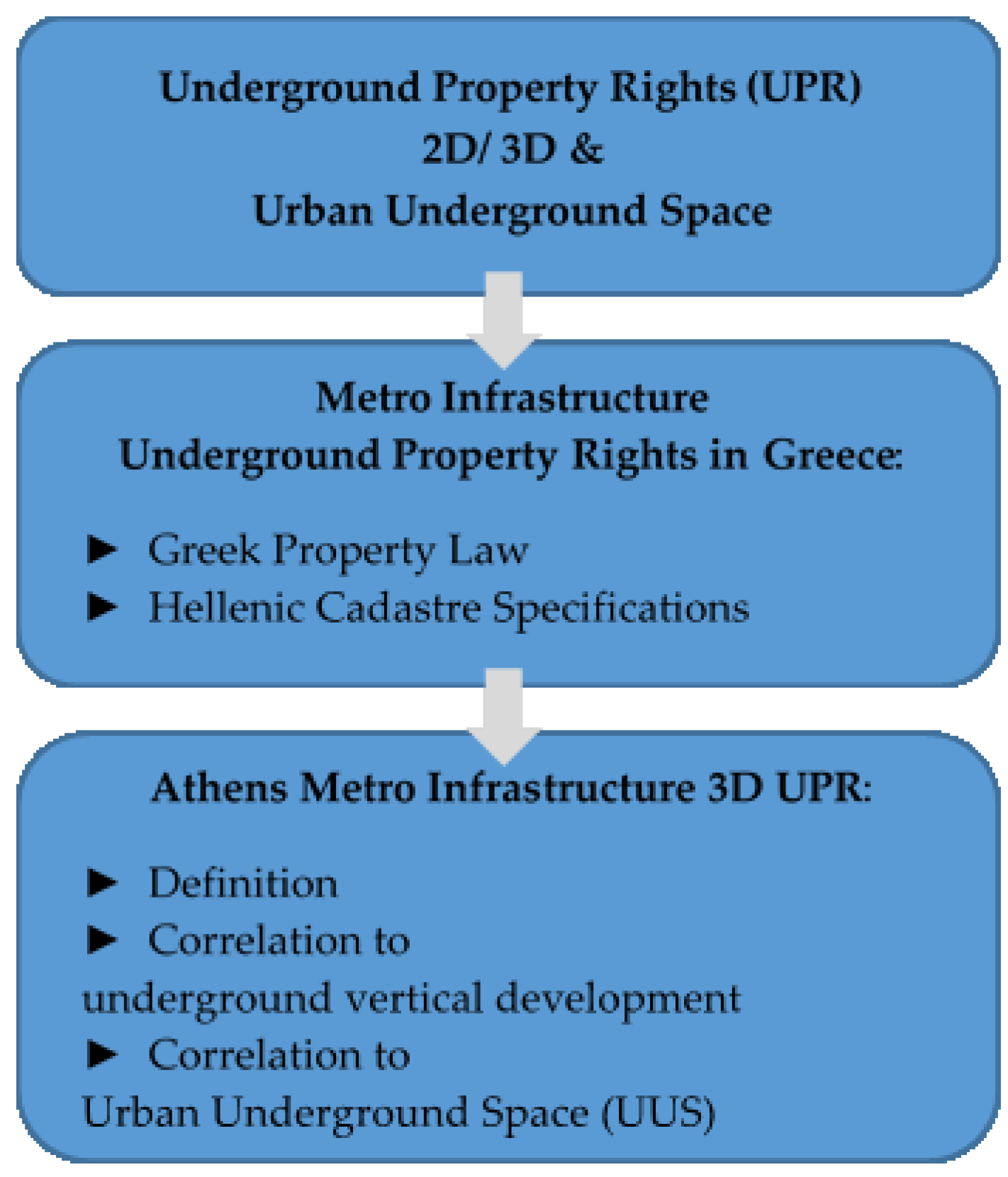
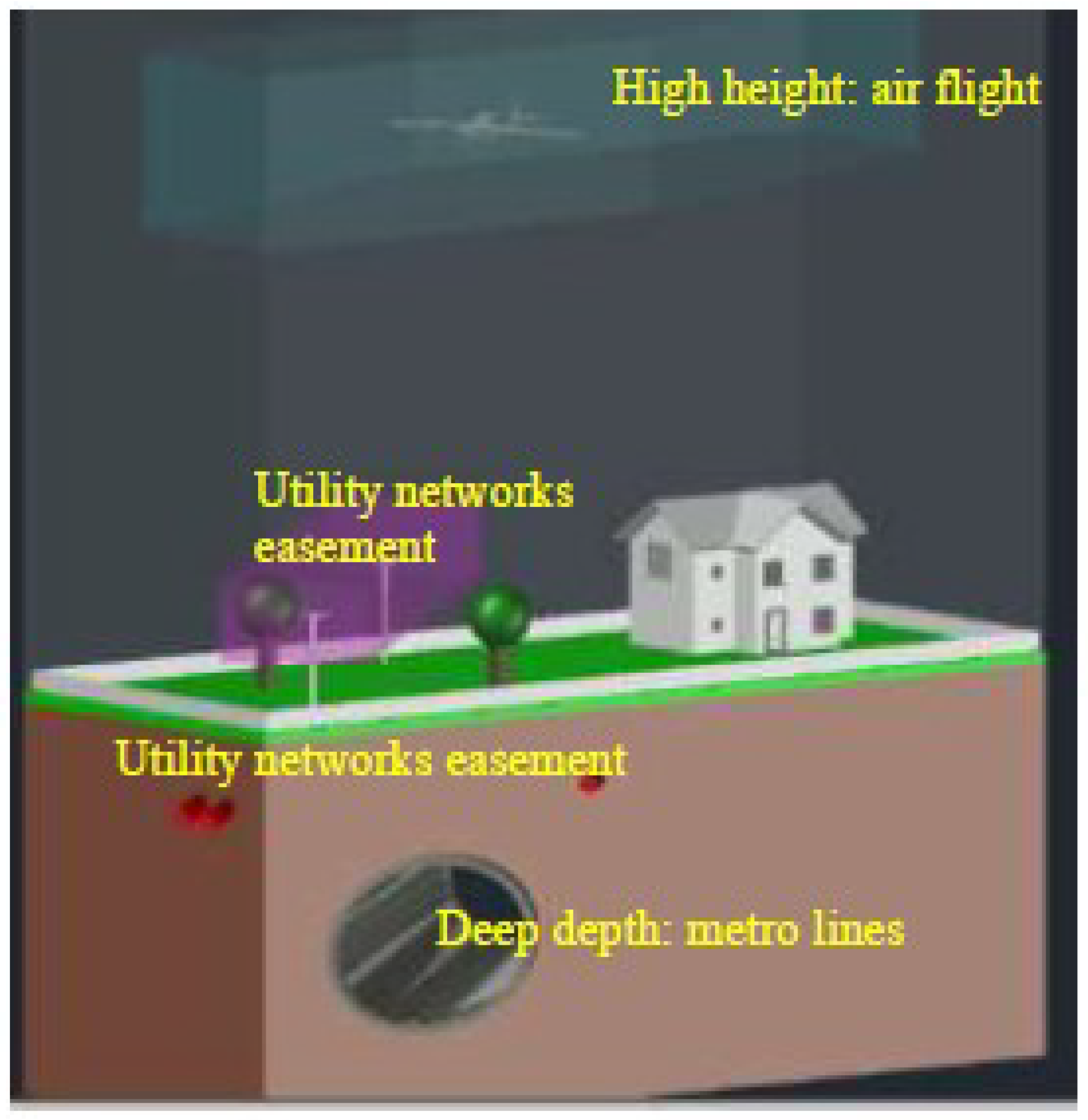

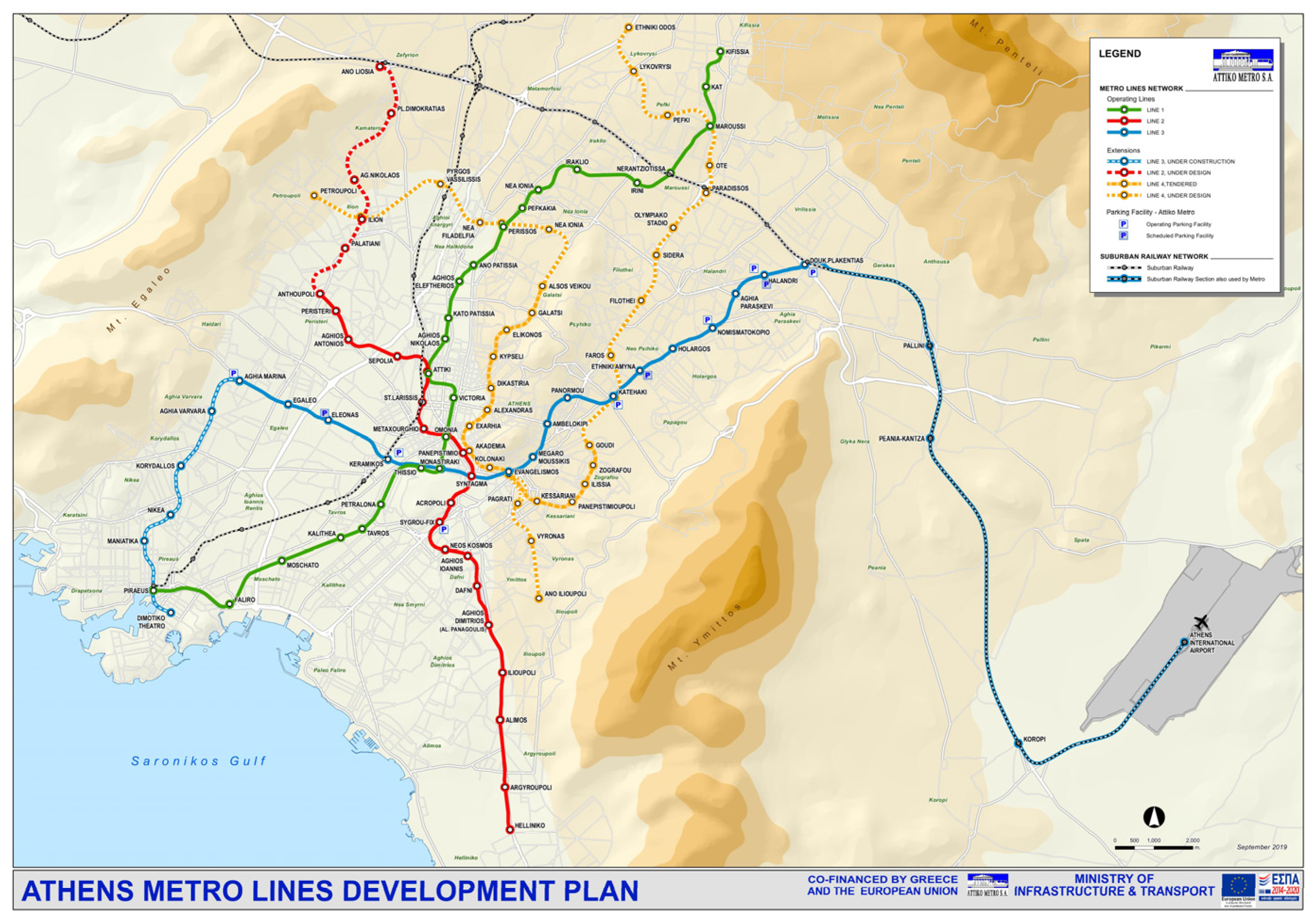

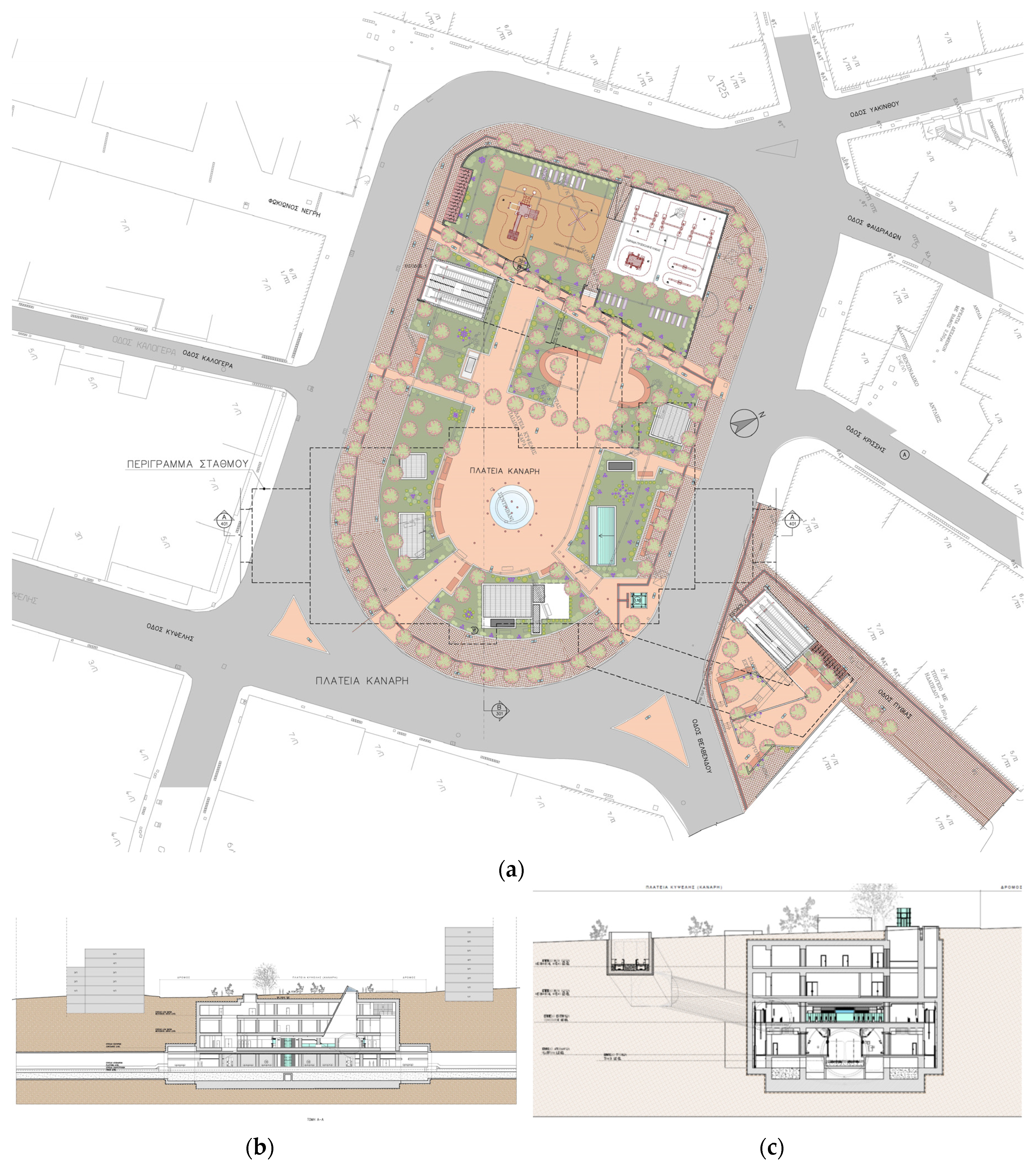

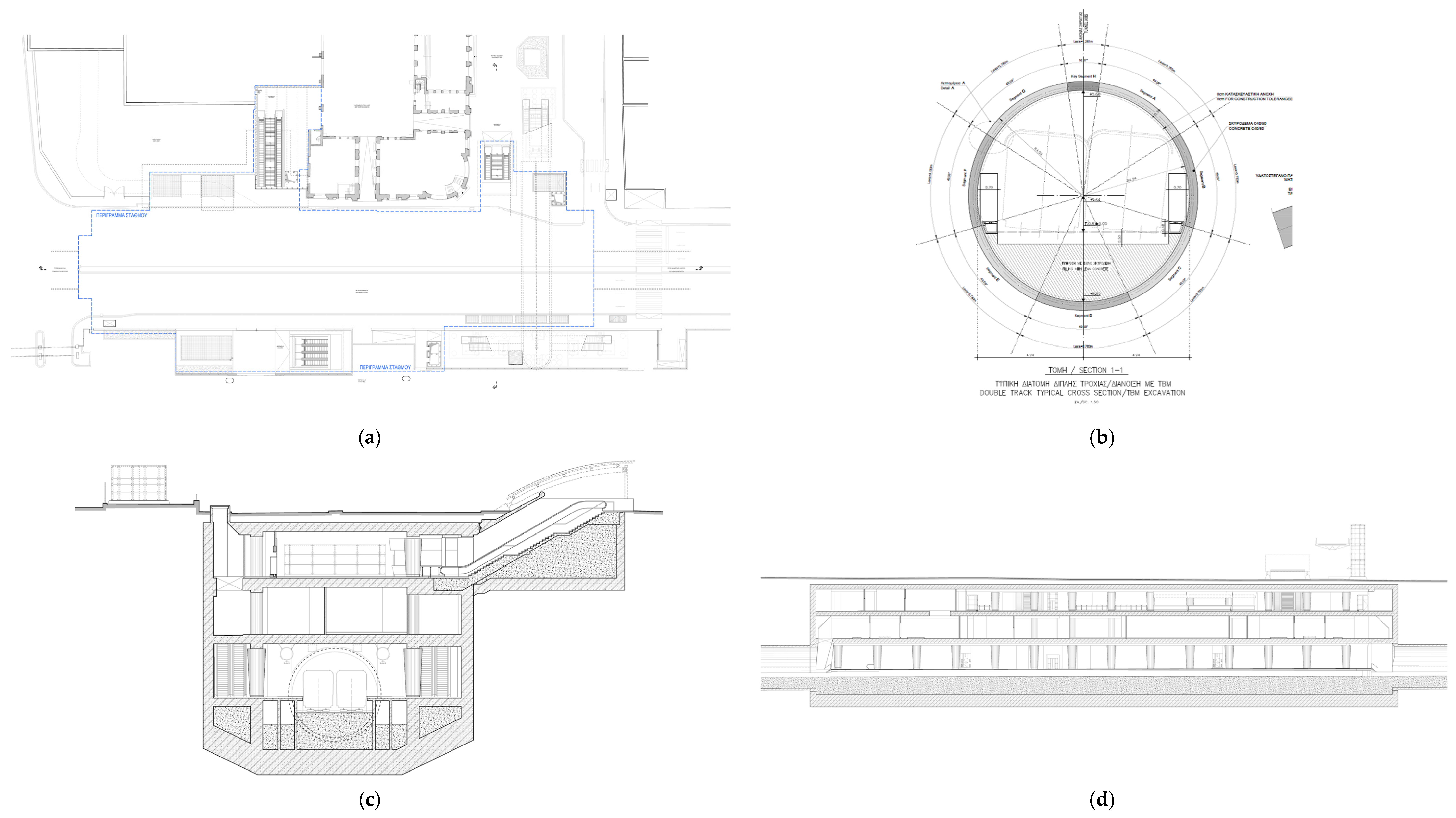
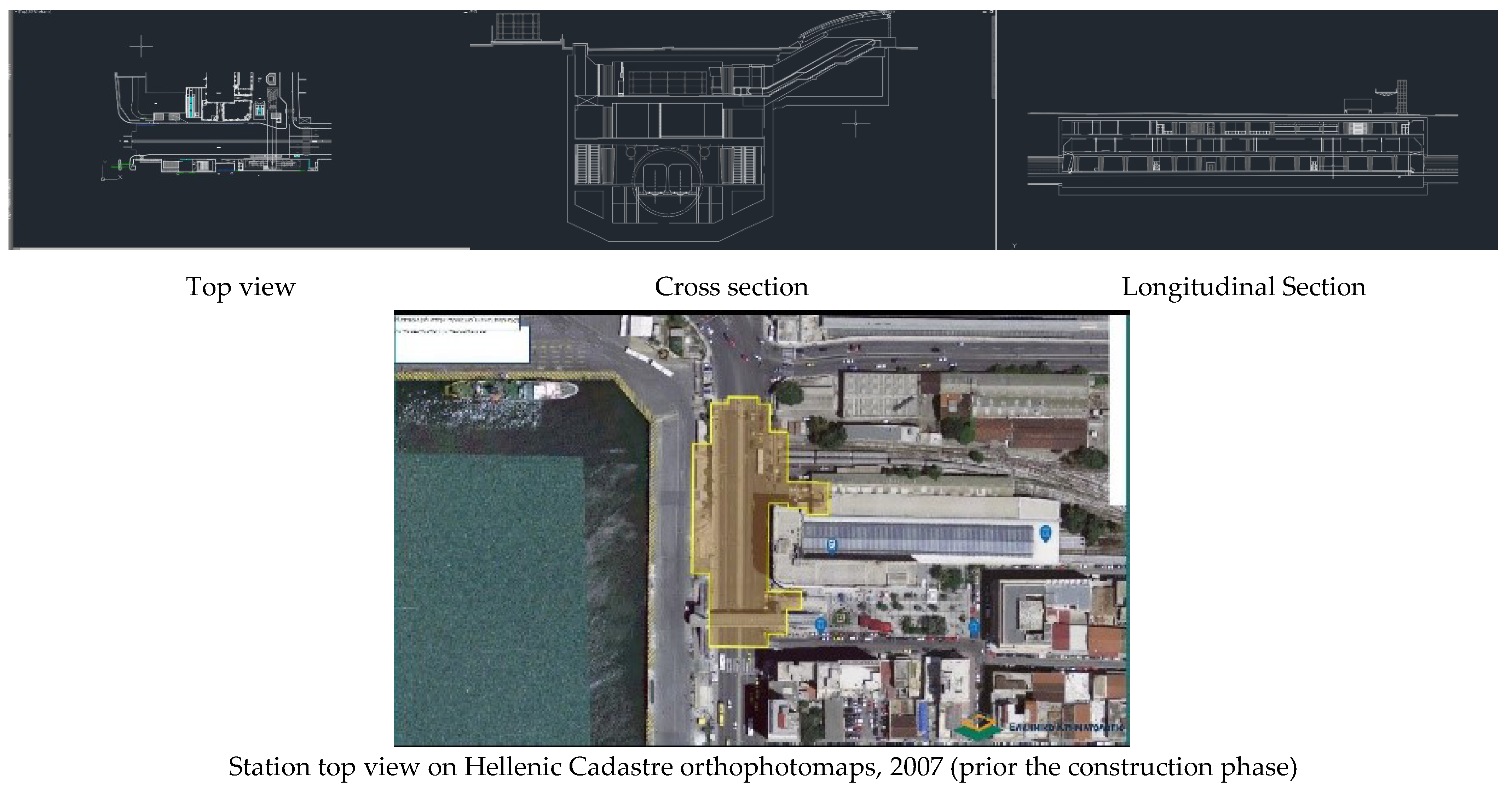
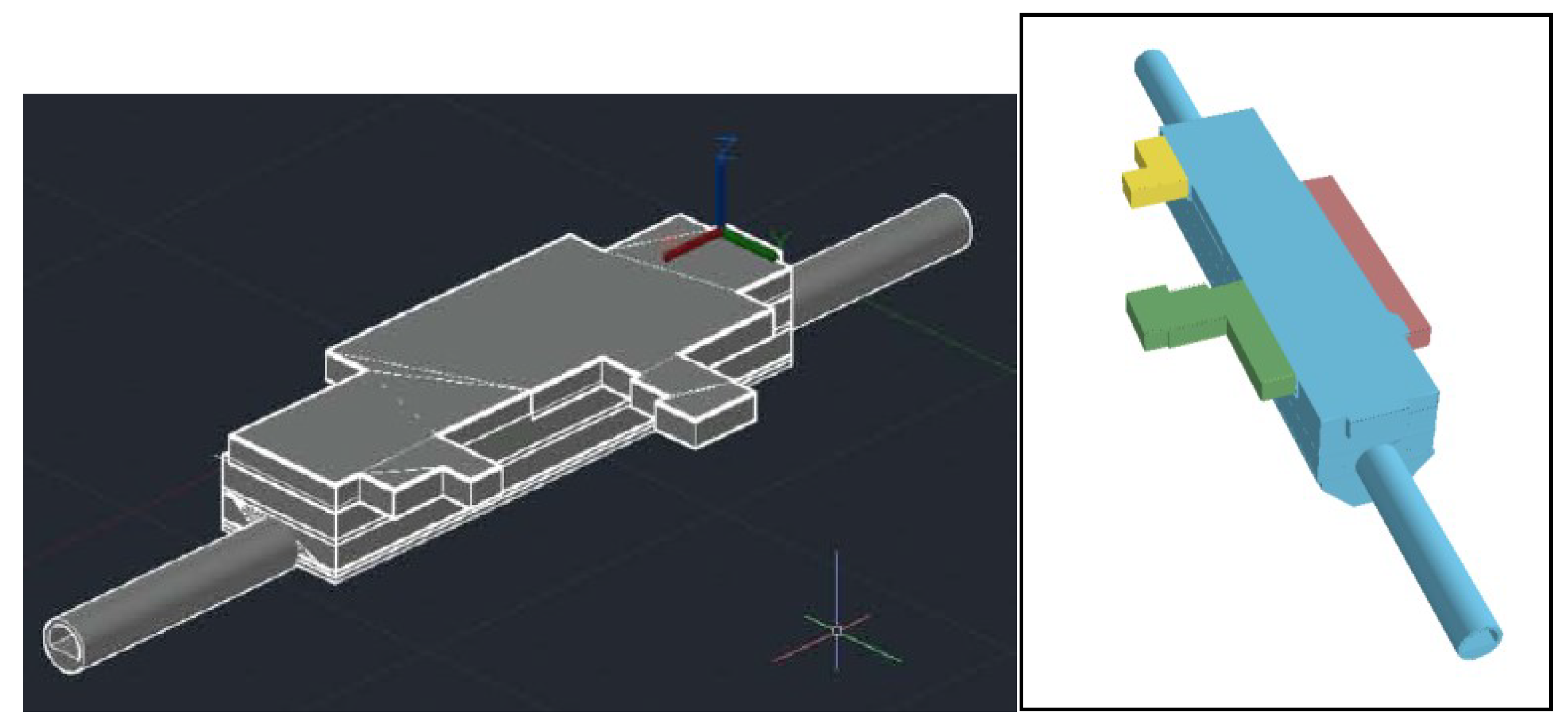
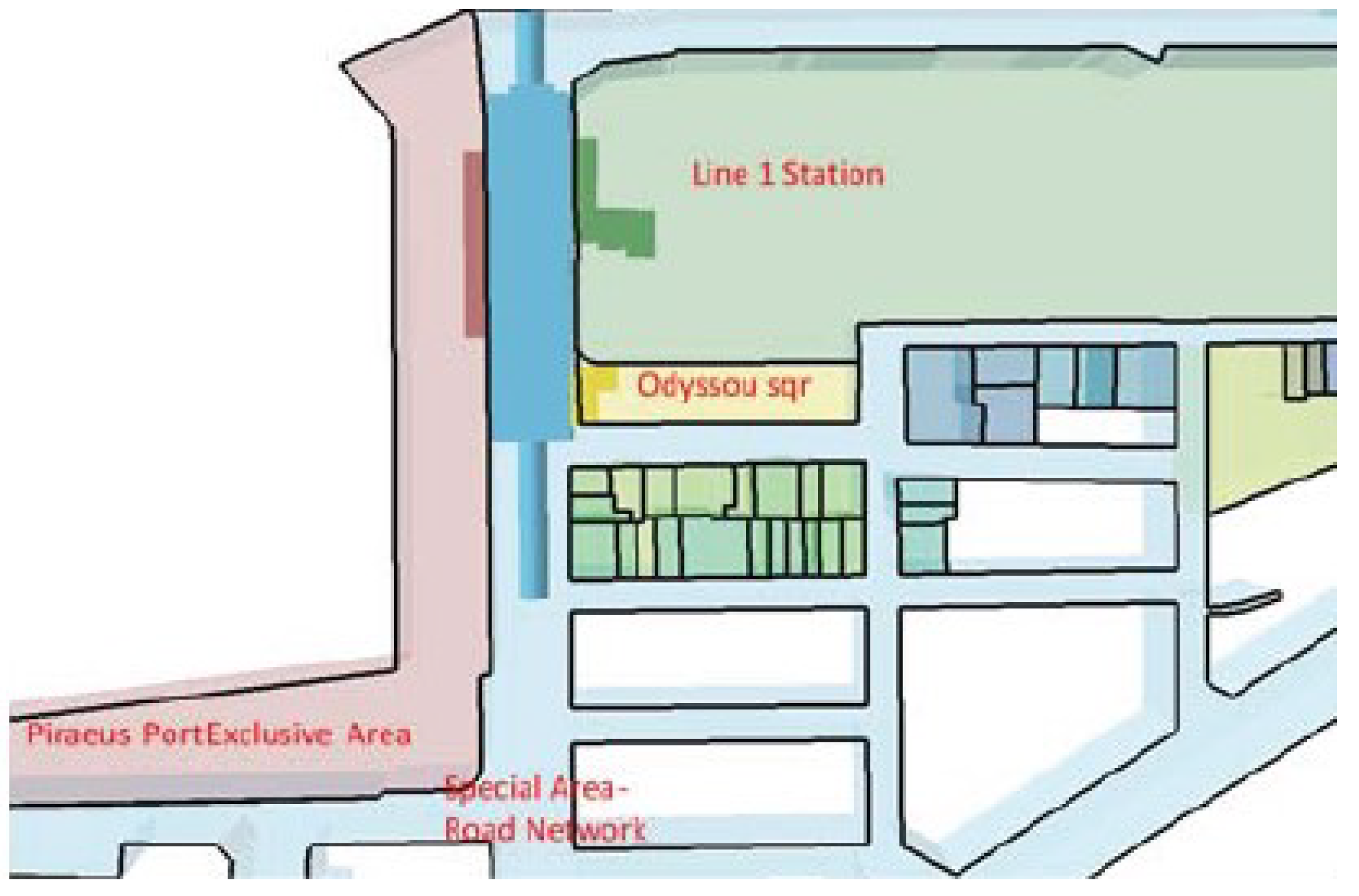

| Piraeus Station UUS 3D Feature | 2D Cadastral Parcel Owner | Type of Right for Metro Infrastructure | Type of Right for Cadastral Parcel Owner |
|---|---|---|---|
| 3D space entrance | |||
| level 0 to 1 | Urban Rail SA, Municipality of Piraeus, Ministry of Finance | Enhanced Ownership rights on use, exploitation, development, maintenance/equivalent to utilities network easement/ possible subjected to compensation | Bare ownership |
| 3D space below entrance | Urban Rail SA, Municipality of Piraeus, Ministry of Finance | None | Full owner ship |
| 3D space main station | |||
| levels 0 to 1/ mechanical area constructions | Urban Rail SA, Municipality of Piraeus, Ministry of Finance | Enhanced Ownership rights on use, exploitation, development, maintenance/ equivalent to easement | Bare ownership |
| levels 1 to 4 | Municipality of Piraeus | Enhanced Ownership rights on use, exploitation, development, maintenance/ equivalent to easement | Bare ownership |
| 3D space below level 4 | Municipality of Piraeus | None | Full owner ship |
| 3D space tunnels | |||
| Level 0 to 3 | Piraeus Municipality | None/possible future further fragmentation for tunnels structural protection from nuisance during construction activities, e.g., vibrations. | Full owner ship |
| Level 3 to 4 | Municipality of Piraeus | Enhanced Ownership rights on use exploitation, development, maintenance/ equivalent to easement | Bare ownership |
| 3D space below tunnels | Municipality of Piraeus | None | Full owner ship |
Publisher’s Note: MDPI stays neutral with regard to jurisdictional claims in published maps and institutional affiliations. |
© 2021 by the authors. Licensee MDPI, Basel, Switzerland. This article is an open access article distributed under the terms and conditions of the Creative Commons Attribution (CC BY) license (https://creativecommons.org/licenses/by/4.0/).
Share and Cite
Perperidou, D.-G.; Sigizis, K.; Chotza, A. 3D Underground Property Rights of Transportation Infrastructures: Case Study of Piraeus Metro Station, Greece. Sustainability 2021, 13, 13162. https://doi.org/10.3390/su132313162
Perperidou D-G, Sigizis K, Chotza A. 3D Underground Property Rights of Transportation Infrastructures: Case Study of Piraeus Metro Station, Greece. Sustainability. 2021; 13(23):13162. https://doi.org/10.3390/su132313162
Chicago/Turabian StylePerperidou, Dionysia-Georgia, Konstantinos Sigizis, and Agkronilnta Chotza. 2021. "3D Underground Property Rights of Transportation Infrastructures: Case Study of Piraeus Metro Station, Greece" Sustainability 13, no. 23: 13162. https://doi.org/10.3390/su132313162
APA StylePerperidou, D.-G., Sigizis, K., & Chotza, A. (2021). 3D Underground Property Rights of Transportation Infrastructures: Case Study of Piraeus Metro Station, Greece. Sustainability, 13(23), 13162. https://doi.org/10.3390/su132313162







